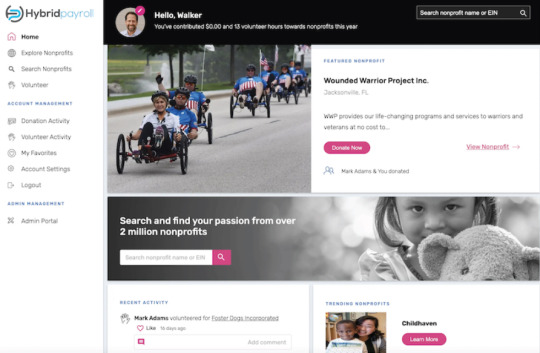We perfected our process by focusing on some of the most high-growth industries in the world. Our success allows us now to serve your industry, whatever it is. Hybrid Payroll is ideal and adaptable for any size business in any niche. Our cloud-based solution enables your teams to work smarter, both in the office and remotely. https://hybridpayroll.com/
Don't wanna be here? Send us removal request.
Text
Workers Compensation Administration Solutions

If one of your employees is injured on the job, you must track their journey, submit, report, and maintain accurate records to ensure compliance. Failure to do so can result in complex issues that could result in fines or other sanctions impacting business continuity. Workers Compensation administration and management is an integral part of our PEO offering. https://hybridpayroll.com/
#hospitality workforce scheduling#real time payroll processing#construction recruitment services#worker compensation management#talent management denver#denver insurance services#retail workforce management
0 notes
Text
Manufacturing Payroll Processing - Hybrid Payroll
Streamlining Manufacturing Payroll Processing: A Guide to Efficiency and Compliance
In the manufacturing industry, payroll processing is more complex than in many other sectors due to factors like multiple shifts, overtime, union regulations, and compliance requirements. Efficient payroll processing ensures employees are paid accurately and on time while keeping the organization compliant with labor laws. This blog explores the key aspects of payroll processing in the manufacturing industry and how businesses can streamline their payroll operations.

Key Challenges in Manufacturing Payroll Processing
Shift Differentials and Overtime Pay: Many manufacturing employees work in multiple shifts, with different pay rates for night shifts or overtime hours. Ensuring correct calculations for these differentials is critical to payroll accuracy.
Compliance with Labor Laws: Manufacturers must comply with labor laws, including the Fair Labor Standards Act (FLSA), Occupational Safety and Health Administration (OSHA) regulations, and state labor laws governing minimum wage, overtime, and break periods.
Union and Contractual Agreements: Many manufacturing workers are part of labor unions, requiring adherence to collective bargaining agreements that dictate wages, benefits, and overtime pay.
Employee Classification: Manufacturers often employ a mix of full-time, part-time, temporary, and contract workers. Misclassification can lead to compliance issues and penalties.
Tracking Work Hours Accurately: The use of manual timesheets or outdated tracking systems can result in errors, leading to payroll discrepancies and employee dissatisfaction.
Best Practices for Efficient Payroll Processing
Automate Payroll with Software Solutions: Investing in payroll software specifically designed for manufacturing can automate calculations for overtime, shift differentials, and deductions, reducing errors and improving efficiency.
Integrate Time Tracking Systems: Using biometric scanners, digital time clocks, or cloud-based attendance systems ensures accurate tracking of employee hours, reducing discrepancies and manual interventions.
Ensure Compliance with Labor Laws: Staying updated on federal, state, and local labor laws helps manufacturers avoid legal penalties. Regular audits of payroll records can also help in maintaining compliance.
Streamline Union and Employee Agreements: Payroll systems should be configured to align with union contracts and company policies. Automating benefits, bonuses, and wage increases based on agreements ensures compliance and fairness.
Use Direct Deposit and Digital Pay Stubs: Digital payroll processing eliminates paper checks, ensuring timely payments and reducing administrative work. Employees also benefit from easy access to their pay records.
Regular Payroll Audits and Reconciliation: Conducting periodic payroll audits helps identify errors before they escalate into compliance issues or disputes. Reconciling payroll with financial records ensures transparency and accuracy.
Final Thoughts
Manufacturing payroll processing can be complex, but with the right technology and best practices, businesses can streamline operations, reduce errors, and ensure compliance with labor laws. By automating payroll, integrating time-tracking systems, and staying informed on regulatory requirements, manufacturers can enhance efficiency and keep their workforce satisfied. Investing in modern payroll solutions is not just a convenience—it’s a necessity for sustainable business growth in the manufacturing sector.
#construction payroll processing#hospitality payroll management#premier payroll services#payroll outsourcing in denver#payroll services denver#small business payroll processing#peo hr solutions#hospitality payroll solutions
0 notes
Text

Employee Volunteering Softwares | HR Solutions Company Denver | Payroll Processing Solutions
Hybrid Payroll Giving and Volunteering provides both employees and employers what they are asking for—alignment with charitable causes plus simple, seamless methods for managing giving programs, processing contributions, and reporting social responsibility. Now, even as a small employer, you can compete for top talent while fostering employee loyalty and retention. https://hybridpayroll.com/giving-and-volunteering/
#Talent Management Denver#Denver Insurance Services#Construction Recruitment Services#Worker Compensation Management#Hospitality Workforce Scheduling#Real Time Payroll Processing
0 notes
Text
Ancillary Services Denver - Hybrid Payroll
What do you mean by ancillary services?
Ancillary services refer to supplemental or secondary services that support or enhance a primary service or product. They are often essential for the overall effectiveness or convenience of the main service but are not the core offering themselves.

Examples of Ancillary Services by Industry:
Healthcare:
Diagnostic services like lab tests or imaging (X-rays, MRIs).
Physical therapy, pharmacy, or rehabilitation services.
Ambulance or home healthcare services.
Travel and Hospitality:
Airport shuttle services or baggage handling.
Room service, spa treatments, or guided tours.
Travel insurance or concierge services.
Technology and Software:
Technical support or training programs.
Cloud storage or data backup services.
Maintenance and updates for software.
Utilities and Energy:
Backup power generation.
Energy efficiency audits or home automation tools.
Retail:
Gift wrapping, delivery, or assembly services.
Extended warranties or customization options.
Characteristics of Ancillary Services:
Supplementary: They add value to the main service/product.
Optional or Required: Some may be optional (e.g., room upgrades), while others may be necessary for proper functioning (e.g., maintenance agreements).
Revenue Streams: They often provide additional revenue opportunities for businesses.
#Talent Management Denver#Denver Insurance Services#Construction Recruitment Services#Worker Compensation Management#Retail Workforce Management#Hospitality Workforce Scheduling#Real Time Payroll Processing
0 notes
Text
HIIT Toronto - Church of Sweat
Get your sweat on at Church of Sweat, High Intensity Interval Trainers Toronto. We offer a variety of high-intensity interval training classes to help you reach your fitness goals. https://www.churchofsweat.ca/
#Local Personal Training Sessions Toronto#Personal Training Downtown Toronto#Best Queer Personal Trainer Toronto#Best Fitness Trainers In Toronto#In Person Fitness Classes Toronto#High Intensity Interval Training Toronto#Hiit Classes Downtown Toronto
0 notes
Text

Workforce Scheduling Solutions - Hybrid Payroll
Hybrid payroll systems streamline workforce scheduling by integrating advanced technologies with human oversight. These solutions optimize shift management, ensuring proper coverage while minimizing overstaffing or conflicts. With features like real-time updates, automated notifications, and compliance tracking, businesses can efficiently coordinate their workforce. Hybrid payroll enhances productivity and employee satisfaction by offering transparent scheduling tools and flexible adjustments, catering to modern workplace dynamics. https://hybridpayroll.com/overcoming-barriers-addressing-challenges-in-adopting-employee-volunteering-software/
#Small Business Payroll App#Real Time Payroll Processing#Hospitality Workforce Scheduling#Retail Workforce Management#Worker Compensation Management#Construction Recruitment Services
0 notes
Text

Mid Sized Payroll Services | Hybrid Payroll Streamline your operations with Hybrid Payroll’s mid-sized payroll services, offering tailored solutions for efficient payroll processing, compliance, and HR support. https://hybridpayroll.com/
0 notes
Text
Construction Onboarding Services - Hybrid Payroll
What is the 4 step onboarding process?
Construction onboarding is the process of integrating new employees, contractors, or subcontractors into a construction project or company. Due to the unique and often hazardous nature of construction work, onboarding in this industry focuses heavily on safety protocols, site-specific procedures, and regulatory compliance. Here's what construction onboarding typically includes:

The 4-step onboarding process generally follows this structure:
Pre-boarding: This step occurs before the new hire’s first day. It includes sending necessary paperwork, setting up workspaces, and providing information about what to expect on day one. It helps ease anxiety and create excitement for the role.
Orientation: The formal introduction to the company, covering company policies, benefits, systems, and a general overview of the organization. This is where new hires meet key people, learn about the company's mission, and get acquainted with the tools they'll be using.
Training: This step focuses on teaching the new hire the specific skills, tools, and processes they need to perform their role. Depending on the complexity of the job, this could range from a few days to several months.
Integration: The final step is ongoing support to ensure the new hire feels fully integrated into the company culture and their team. This could involve mentorship, regular check-ins, and continued learning opportunities to solidify their role within the organization.
Following this process helps ensure a smooth transition and sets the employee up for long-term success.
#retail industry hr services#workforce ancillary management#small business payroll outsource#peo management software#finance industry payroll solutions#enpense management services#hospitality workforce scheduling#real time payroll processing
0 notes
Text
Hospitality Payroll Management: Hybrid Payroll Solutions

Streamline your hospitality payroll with Hybrid Payroll solutions. Our advanced system simplifies wage calculations, tax compliance, and benefits management, tailored specifically for the unique needs of the hospitality industry. Experience efficient payroll processing and robust support with our customizable tools designed to enhance your operational efficiency. Discover how Hybrid Payroll can transform your payroll management today. https://hybridpayroll.com/
0 notes
Text
Local Payroll Services Denver - Hybrid Payroll
What is HR and payroll services?
HR and Payroll Services
HR and payroll services are essential functions within an organization that involve managing employee-related tasks, financial compensation, and compliance with tax and labor regulations. Here's what the search results reveal:

1. HR Services: Human Resources (HR) departments are responsible for various functions related to employee management. Some key HR services include:
Employee Relations: HR departments handle employee relations, including recruitment, onboarding, training, performance management, and addressing employee concerns.
Benefits Administration: HR manages employee benefits, such as health insurance, retirement plans, and leave policies.
Payroll Processing: While payroll is often considered a separate function, HR departments may also handle payroll processing, including calculating wages, deductions, and ensuring compliance with tax laws.
Compliance: HR ensures compliance with labor laws, regulations, and company policies.
Data Analysis: HR departments analyze employee data to gain insights into workforce trends, performance, and engagement.
2. Payroll Services: Payroll services primarily focus on the financial aspects of employee compensation. Some key payroll services include:
Payroll Processing: Payroll services handle the calculation and distribution of employee wages, including deductions, taxes, and benefits.
Tax Filing: Payroll services ensure accurate and timely filing of payroll taxes and compliance with tax regulations.
Reporting: Payroll services generate reports on payroll-related metrics, such as compensation, deductions, and taxes paid.
Employee Self-Service: Payroll services often provide online portals for employees to access their pay stubs, view and update personal information, and manage benefits.
While HR and payroll services have distinct responsibilities, there are areas of overlap, such as coordinating employee-related information and ensuring confidentiality of sensitive data.
It's worth noting that there are various HR and payroll service providers available, each offering different features and capabilities. Some popular providers include Gusto, Paychex Flex, QuickBooks Online, and ADP.
Remember to consider the specific needs and size of your business when choosing HR and payroll services. Conducting thorough research and evaluating different providers will help you find the best fit for your organization.
#enpense management services#benefits enrollment software#manufacturing payroll denver#small business payroll help#ancillary services denver#benefit administration software#hospitality industry hr services#retail workforce management
0 notes
Text
Health Benefits Software Solutions For Every Industry | Payroll Processing Solutions Denver

Managing benefits can be complex and time-consuming. Trust Hybrid Payroll to help you stay compliant while giving employees the benefits they want and need. You’ll have access to COBRA management, flexible spending accounts, health savings accounts, health reimbursement and transportation/parking plans, all delivered by a company with over 30 years of experience in the benefits industry. https://hybridpayroll.com/
#manufacturing payroll software#the payroll company 401k#peo hr software#finance industry payroll services#construction peo management#payroll management solutions#hemp payroll company denver#ancillary insurance denver#hr solutions for financing business#construction onboarding services
0 notes
Text
Streamlining Business Operations with Denver's Hybrid Payroll Outsourcing Services

In the ever-evolving landscape of business operations, managing payroll efficiently is paramount for businesses of all sizes. Small to mid-sized enterprises often face challenges in handling payroll processes effectively while simultaneously focusing on core business activities. This is where Hybrid Payroll, a leading provider of payroll outsourcing services in Denver, steps in to offer tailored solutions that streamline payroll management and enhance organizational efficiency.
Understanding Hybrid Payroll Outsourcing
Hybrid Payroll specializes in offering comprehensive payroll outsourcing services that combine the advantages of traditional payroll processing with cutting-edge technology solutions. By leveraging a hybrid approach, businesses can benefit from the expertise of seasoned payroll professionals along with the efficiency and convenience of advanced payroll software.
Tailored Solutions for Diverse Business Needs
One of the key features of Hybrid Payroll's services is their commitment to providing customized solutions tailored to the unique requirements of each client. Whether it's a small startup, a growing mid-sized business, or an established enterprise, Hybrid Payroll understands that one size does not fit all when it comes to payroll management.
Key Features and Benefits
Accuracy and Compliance: Hybrid Payroll ensures accurate and compliant payroll processing, keeping abreast of ever-changing tax regulations and labor laws. This alleviates the burden of staying compliant from businesses and reduces the risk of costly errors.
Time and Cost Savings: By outsourcing payroll functions to Hybrid Payroll, businesses can save valuable time and resources that would otherwise be spent on payroll administration. This allows organizations to focus on core business activities and strategic initiatives while leaving payroll complexities to the experts.
Access to Advanced Technology: Hybrid Payroll employs state-of-the-art payroll software and technology platforms to streamline processes and enhance efficiency. Clients have access to intuitive payroll portals, automated reporting tools, and seamless integration with accounting systems, ensuring a seamless payroll experience.
Dedicated Support: With Hybrid Payroll, clients benefit from dedicated support from a team of experienced payroll professionals who are committed to providing personalized assistance and resolving any payroll-related inquiries promptly.
Seamless Integration and Scalability
Hybrid Payroll's services are designed to seamlessly integrate with existing business systems and processes, ensuring minimal disruption during the transition phase. Whether businesses are expanding, downsizing, or undergoing organizational changes, Hybrid Payroll's scalable solutions can adapt to evolving needs and grow alongside the business.
Conclusion
In today's fast-paced business environment, efficient payroll management is essential for driving growth and maximizing operational efficiency. With Hybrid Payroll's comprehensive outsourcing services, businesses in Denver can streamline payroll processes, mitigate compliance risks, and focus on what truly matters – building a successful and thriving enterprise. By leveraging the expertise and technology offered by Hybrid Payroll, businesses can unlock new opportunities for growth while leaving the complexities of payroll management in capable hands.
#manufacturing payroll software#peo hr software#ancillary insurance denver#finance industry payroll services#construction onboarding services#hr solutions for financing business#construction peo management#hemp payroll company denver#the payroll company 401k#payroll management solutions
0 notes
Text
Worker Compensation Management - Hybrid Payroll
What is workers compensation in HRM?
Workers' compensation, often referred to as workers' comp or workman's comp, is a system of insurance that provides financial and medical benefits to employees who are injured or become ill as a result of their job. In the context of Human Resource Management (HRM), workers' compensation is a critical component of employee welfare and safety.

Key aspects of workers' compensation in HRM include:
Insurance Coverage: Employers typically purchase workers' compensation insurance to cover the costs associated with workplace injuries or illnesses. This insurance provides benefits to employees to cover medical expenses, rehabilitation costs, and a portion of their lost wages.
Legal Compliance: In many jurisdictions, employers are legally required to carry workers' compensation insurance. Compliance with these regulations is an essential responsibility of the HR department. Failure to comply with these laws can result in legal consequences for the employer.
Claims Management: HR professionals are often involved in managing workers' compensation claims. This involves coordinating the reporting and processing of claims, working with insurance providers, and ensuring that injured employees receive the appropriate benefits.
Return-to-Work Programs: HRM may be responsible for implementing return-to-work programs that facilitate the smooth transition of employees back to the workplace after recovering from a work-related injury. This can involve modified duties or accommodations to support the employee's rehabilitation.
Safety Programs: A proactive approach to workplace safety is crucial in preventing accidents and injuries. HRM plays a role in developing and implementing safety programs to reduce the risk of workplace incidents, which, in turn, can help control workers' compensation costs.
Communication: HR professionals often act as intermediaries between employees, management, and insurance providers. Effective communication is essential in keeping all stakeholders informed about the workers' compensation process, rights, and responsibilities.
Recordkeeping: HR departments are typically responsible for maintaining accurate records related to workplace injuries and illnesses. This includes documenting incidents, tracking medical treatment, and ensuring compliance with regulatory reporting requirements.
Workers' compensation is designed to protect both employees and employers. Employees receive financial and medical support when they suffer work-related injuries, and employers gain protection against legal action related to workplace injuries. HRM plays a pivotal role in ensuring that the workers' compensation process is administered effectively and in compliance with relevant laws and regulations.
#worker compensation management#construction recruitment services#time and labor management#small payroll companies#construction peo management#denver insurance services#talent management denver#hospitality payroll management
0 notes
Text

Employee Performance Solutions - Hybrid Payroll
Recognizing employees beyond the context of work serves as a valuable post-pandemic opportunity—one that can boost employee engagement and customer experience. With Hybrid Payroll Share and Perform, enable multi-directional employee communication that drives toward a transformative company culture. Built-in employee recognition and performance management tools allow both employees and managers to engage in maximum business success. https://hybridpayroll.com/share-and-perform/
#Hemp Payroll Company Denver#Construction Onboarding Services#Hr Solutions For Financing Business#Payroll Outsourcing Services Denver#Payroll Management Solutions#Hospitality Onboarding Services#Cannabis Business Payroll
0 notes
Text
Talent Management in Denver - Hybrid Payroll
What is a talent management system?
A talent management system refers to a suite of software applications and strategies designed to effectively recruit, develop, retain, and manage a company’s workforce. It encompasses various HR functions and processes related to attracting, nurturing, and retaining talent within an organization.

Key components of a talent management system typically include:
Recruitment and Applicant Tracking: Tools for sourcing, attracting, and managing job applicants. This includes job postings, resume screening, and applicant tracking systems.
Performance Management: Systems for setting goals, evaluating performance, providing feedback, and identifying areas for employee development.
Learning and Development: Platforms for training, skill development, and career advancement opportunities, such as online courses, workshops, and personalized learning paths.
Succession Planning: Strategies and tools for identifying and developing future leaders within the organization to fill key roles when needed.
Employee Engagement and Retention: Methods to gauge employee satisfaction, gather feedback, and create strategies to enhance workplace satisfaction and retention.
Analytics and Reporting: Tools that collect and analyze data on various HR metrics to provide insights for better decision-making.
The goal of a talent management system is to align an organization’s workforce with its business goals, ensuring that it attracts and retains top talent while fostering employee growth and development. These systems help streamline HR processes, enhance employee engagement, and contribute to overall organizational success.
Is talent management a HR?
Talent management is closely associated with HR (Human Resources) as it involves strategies and practices related to the acquisition, development, and retention of employees within an organization. In many companies, talent management falls under the umbrella of HR functions.
While HR traditionally focuses on various aspects of employee management, such as hiring, compensation, benefits, and compliance, talent management specifically emphasizes the strategic approach to attracting, nurturing, and retaining top talent. It’s often considered a more proactive and long-term perspective within the broader field of HR.
Talent management extends beyond traditional HR functions by emphasizing the identification of high-potential employees, succession planning, leadership development, and creating an environment that fosters employee growth and engagement.
In summary, while talent management is closely related to HR, it represents a more specialized and strategic aspect of managing human capital within an organization.
#Hospitality Ancillary Insurance#Hemp Payroll Company Denver#Construction Onboarding Services#Hr Solutions For Financing Business#Payroll Outsourcing Services Denver#Payroll Management Solutions
0 notes
Text
Choosing the Right Denver Insurance Services for Your Business

1. Introduction to Denver Insurance Services: Denver Insurance Services is a reputable insurance agency located in the heart of Denver, dedicated to providing comprehensive insurance solutions to individuals and businesses alike. With a team of experienced professionals and a commitment to excellent customer service, Denver Insurance Services has earned a stellar reputation in the insurance industry.
2. Wide Range of Insurance Products: Denver Insurance Services offers a diverse range of insurance products tailored to meet the unique needs of their clients. Whether it's auto, home, health, life, or commercial insurance, the agency provides personalized and cost-effective coverage options. Their wide selection ensures that clients can find policies that fit their requirements and budget, giving them peace of mind in various aspects of their lives and businesses.
3. Expert Guidance and Advice: One of the standout features of Denver Insurance Services is their team of knowledgeable experts who offer expert guidance and advice to clients. Understanding that insurance can be complex and confusing, the agency's professionals take the time to explain policies thoroughly, helping clients make informed decisions. Their expertise ensures clients have a clear understanding of their coverage, allowing them to choose the best options for their specific circumstances.
4. Exceptional Customer Service: Denver Insurance Services takes pride in its exceptional customer service. The agency prioritizes client satisfaction, going above and beyond to assist clients throughout the insurance process. Whether it's filing a claim, reviewing policy details, or answering queries, their friendly and dedicated staff are always ready to help. This commitment to outstanding customer service has garnered trust and loyalty from their clients over the years.
5. Community Engagement and Trust: Beyond their professional services, Denver Insurance Services actively engages with the local community, demonstrating their commitment to making a positive impact. By participating in community events, supporting local initiatives, and fostering trust through transparent business practices, the agency has become a trusted partner for insurance needs in Denver. Clients appreciate their integrity, reliability, and genuine concern for the community, making Denver Insurance Services a top choice for insurance solutions in the region.
#the payroll company 401k#peo hr software#manufacturing payroll software#finance industry payroll services#ancillary insurance denver
0 notes
Text
Construction Ancillary in Services - Hybrid Payroll
What is ancillary in construction?
In the context of construction, the term "ancillary" refers to something that is supplementary, auxiliary, or secondary to the main structure or primary components of a building or facility. Ancillary elements are typically supportive or complementary in nature and are not considered the central or essential parts of the construction project.

Examples of ancillary components in construction include:
Ancillary Buildings: These are smaller structures that support the main building's functions. Examples include storage sheds, utility buildings, and garages.
Ancillary Rooms or Spaces: These are additional rooms or spaces within a building that serve specific purposes but are not part of the core functional areas. For instance, in a hospital, ancillary spaces might include janitorial closets, mechanical rooms, or maintenance workshops.
Ancillary Equipment: This refers to equipment that supports the operation of a building or facility but isn't directly part of its primary functions. Examples include backup generators, HVAC equipment, and fire suppression systems.
Ancillary Services: These are services that are secondary to the main functions of the building. For example, in a hotel, ancillary services might include laundry, concierge, and room service.
Ancillary Structures: These are structures that are connected to or associated with the main building but have distinct functions. A common example is a canopy or awning at the entrance of a building.
In summary, "ancillary" in construction refers to elements that are not central to the main purpose of a building but are nonetheless essential for supporting its functionality and overall operation.
What are the different types of ancillary services?
Ancillary services refer to various support functions that help maintain the stability, reliability, and quality of an electricity grid. These services ensure that the supply and demand of electricity are balanced and that the grid operates smoothly. The specific types of ancillary services can vary depending on the grid's characteristics and the regulatory framework in place. Here are some common types of ancillary services:
Frequency Regulation: This service involves maintaining the grid's frequency within a specific range (e.g., 50 Hz or 60 Hz) by adjusting the generation output. Generators or other resources can increase or decrease their output to match changes in load and prevent frequency deviations that could lead to instability.
Voltage Control: Voltage levels need to be maintained within certain limits to ensure the proper functioning of electrical equipment. Voltage control involves managing reactive power supply and demand to maintain stable voltage levels.
Load Following or Load Balancing: Ancillary services help match electricity generation with consumer demand in real-time. When demand fluctuates, resources are adjusted to ensure that supply meets load without significant deviations.
Reserve Capacity: Reserves are additional generation capacity held in readiness to quickly respond to sudden changes in demand or generation disruptions. This ensures grid stability even during unexpected events.
Black Start Capability: Some power plants or resources are equipped to restart the grid in case of a total blackout. These resources can initiate the grid's restoration process without relying on external power sources.
Spinning Reserves: These are generation units that are synchronized with the grid and can quickly increase their output to cover unexpected increases in demand or compensate for sudden generator failures.
Non-Spinning Reserves: These are generation units that are not synchronized with the grid but can start and provide power within a certain timeframe. They provide an additional layer of backup to ensure grid stability.
Replacement Reserves: Similar to spinning and non-spinning reserves, replacement reserves are resources that can be brought online relatively quickly to replace a failed generator or compensate for an unexpected event.
Regulation and Frequency Response: Resources capable of rapidly adjusting their output in response to small fluctuations in frequency. This helps maintain a stable grid by preventing frequency deviations.
Energy Storage: Batteries and other energy storage systems can provide ancillary services by storing excess energy during low-demand periods and releasing it during high-demand periods, thus helping with load balancing and stability.
Demand Response: Incentivizing consumers to adjust their electricity consumption based on grid conditions can help manage peak demand and avoid grid congestion.
Ancillary Services Market: In some regions, there are markets where these services are bought and sold. Grid operators procure these services from various resources to ensure grid stability.
It's important to note that the availability and types of ancillary services can vary depending on the technological capabilities of the grid, the mix of generation resources, and the regulatory environment.
#401k outsourcing in denver#finance industry payroll services#peo payroll providers denver#expense management help denver#ancillary services insurance#ancillary insurance denver#construction ancillary services#construction peo management
0 notes